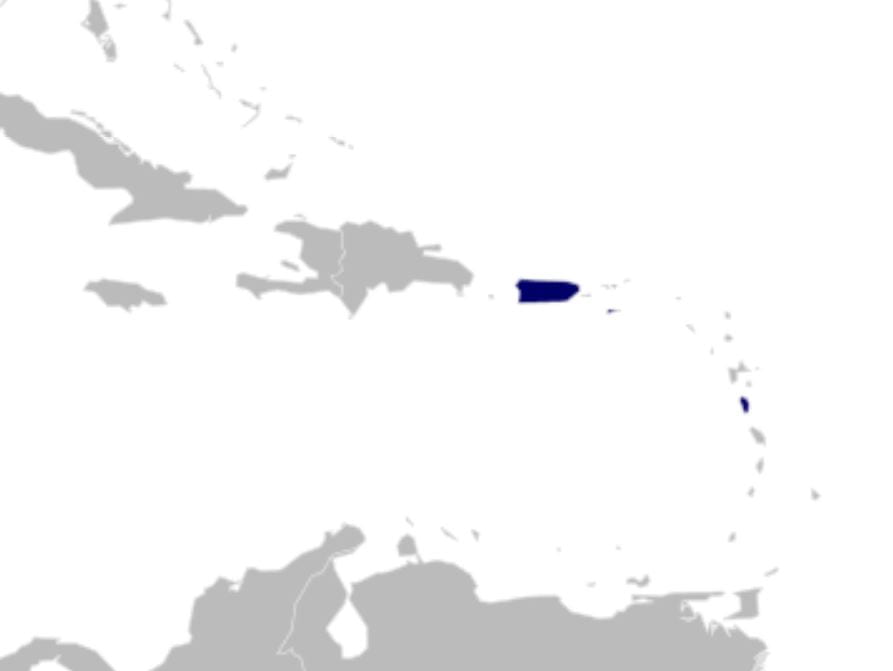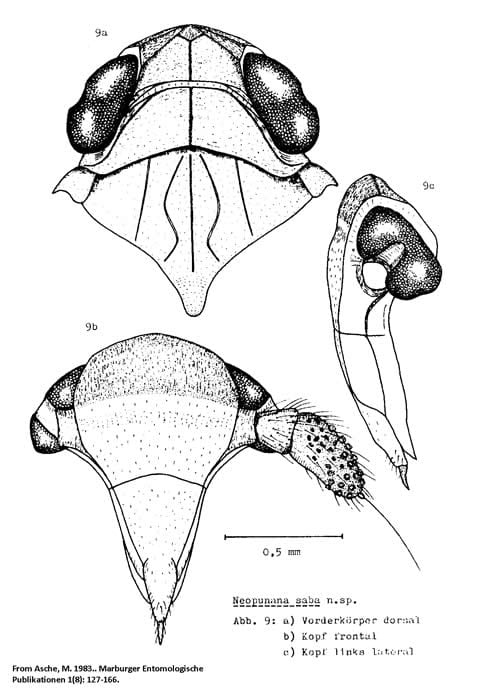[back to Higher Classification of Delphacidae]
[back to A checklist of New World delphacid species]
Contents
Family Delphacidae Leach, 1815
Subfamily Asiracinae Motschulsky 1863: 108.
Tribe Neopunanini Emeljanov 1995
This tribe contains only the genus Neopunana Asche 1983.
Genus Neopunana Asche 1983
Type species Neopunana saba Asche 1983
Synonyms
none
Distribution
Caribbean
Included species
There are 8 species in the genus. Bartlett (2000) noted some undescribed species, but I never got around to describing them.
Neopunana alapa (Caldwell, 1951) – Puerto Rico
= Punana alapa Caldwell, 1951 (in Caldwell and Martorell, 1951).
= Neopunana alapa (Caldwell, 1951); new comb. by Asche, 1983: 139.
Neopunana caribbensis (Caldwell, 1951) – Puerto Rico (Vieques Is.), Virgin Islands (Guana, St. Thomas)
= Punana caribbensis Caldwell, 1951 (in Caldwell and Martorell, 1951).
= Neopunanacaribbensis (Caldwell, 1951); new comb. by Asche, 1983: 139
Neopunana dolon (Fennah, 1959) – Montserrat, St. Kitts
= Punana dolon Fennah, 1959
= Neopunana dolon (Fennah, 1959); new comb. by Asche, 1983: 139.
Neopunana dominicana (Fennah, 1959) – Dominica
= Punana dominicana Fennah, 1959.
= Neopunanadominicana (Fennah, 1959); new comb. by Asche, 1983: 139.
Neopunana puertoricensis (Muir, 1918) – Puerto Rico
= Punana puertoricensis Muir, 1918.
= Neopunana puertoricensis (Muir, 1918); new comb. by Asche, 1983: 139.
Neopunana robusta (Caldwell, 1951) – Puerto Rico
= Punana robusta Caldwell, 1951 (in Caldwell and Martorell, 1951).
= Neopunana robusta (Caldwell, 1951); new comb. by Asche, 1983: 139.
Neopunana saba Asche, 1983 – Saba
Neopunana vulgaris (Caldwell, 1951) – Puerto Rico
= Punana vulgaris Caldwell, 1951 (in Caldwell and Martorell, 1951).
= Neopunana vulgaris (Caldwell, 1951); new comb. by Asche, 1983: 139.
Plant Associations
Neopunana puertoricensis – Castilla elastica Sessé ex Cerv. (Rosales, Moraceae) (from Caldwell and Martorell, 1951)
See plant associations listed in FLOW. I collected Neopunana caribbensis on Guana Island (BVI) where it was common beating woody vegetation, but I did not have the presence of mind at the time to determine what plants it was associated with.
Recognition
A detailed look at the features of the subfamily Asiracinae is here.
The features ascribed to the tribe Neopunanini by Emeljanov (1995) are:
“This tribe is characterized by having a wide, short head, absence of a distinct median eumetopic* carina, S-shaped bend in the distal segment of the penis where its basal part is curved to the right, an even tow of 4 teeth on the second segment of the hind tarsus , presence of sinus on the margin of the hindwings opposite the tip of CuP, in having the tips of CuP and Pcu approximated, and in having the median carinae of the mesonotum developed throughout the entire length and undulating” (pp. 135, 138).
*The eumetopa is essentially the frons below the curvature of the fastigium.This tribe is exclusively New World, and all species have been described from the Caribbean. The Neopunanini is most similar to members of the Platysystatini and Tetrasteirini, but are much larger and differ in features of the head.
Recognition and features of the tribe and genus
Asche, 1983 (p. 128, English summary), in establishing the genus stated (to distinguish the genus from the Indomalayan Punana Muir 1913 and New World relatives) [there may be OCR errors, but I think I have gotten them]
The second group concerns exclusively the Caribbean Punana-species‚ which obviously seem to be closely related to each other. Belonging to the Ugyopini these species seem to possess the most plesiomorphic Configuration of the aedeagus within this tribe (distal part not circularly bended caudad, but reaching 3 straight till the basis of the sheath). On the other hand these species possess some apparently derived characters (e.g. configuration of spinulation of the distal part of the aedeagus‚ shape of the antennae)‚ according to those this group most probably seems to be monophyletic. Synapomorphic characters of
this group with the indomalayan Punana—taxa including the genotype or any other Ugyopini-taxa could not be discovered, thus for these Caribbean Punana—taxa a new genug is established: Neopunana gen. nov.‚ Typus generis = Neopunana saba nov. spec.‚ described from Saba (COBBEN leg.).”
Description from Caldwell and Martorell 1951
Flattened forms. Vertex at least twice as broad as long, with small apical fovae; very broadly truncate on posterior margin between center of eyes. Face very broad, with obscure median carina and usually more obscure intermediate carinae. Second segment of antenna longer than first. Mesonotum with five carinae. Fore wing strongly granulate; Cu forking at apical third before nodal line. Calcar spiniform. All species with a broad dark
band across base of frons between eyes. Aedeagus with apical processes; functional orifice between or basal to processes.
Key to species Neopunana from Puerto Rico and vicinity (from Caldwell and Martorell 1951)
1 Aedeagus with medioapical process four times as long as either lateral; right process very sinuate … puertoricensis
1- Aedeagus with apical and lateral processes of equal length or with two apical
processes … 2
2 Aedeagus with either lateroapical process as long as apical. … vulgaris
2- Aedeagus with one pair apical processes in addition to others … 3
3 Aedeagus with a lateral process on either side in addition to a pair of apical processes … robusta
3- Aedeagus with only three processes; lateral one much reduced … 4
4 Aedeagus with right apical process longer than left, strongly curved; small lateral process present on left … caribbensis
4- Acdeagus with apical process subequal in length; small lateral process present on
right … alapa
Neopunana saba
Online resources
TaxonPages.
iNaturalist.
EOL.
Discover Life.
FLOW.
American Insects. (link is to family, genus not present)
BOLD. (the genus is not present, link to family)
Molecular resources
BOLD has no data for the genus at this time (28 June 2017); Genbank has some data for Neopunana caribbensis.
Selected References
Asche, M. 1983. Aufgliederung der Asiracinen-Gattung Punana Muir, 1913: Equasystatus gen. nov. aus Equador und Neopunana gen. nov. von den Karibischen Inseln (Homoptera Auchenorrhyncha Fulgoromorpha Delphacidae). Marburger Entomologische Publikationen 1(8): 127-166.
Barringer, L.E. & C.R. Bartlett. 2011. A review of New World Asiracinae (Hemiptera: Auchenorrhyncha: Delphacidae) with five new taxa. Cicadina 12: 7-39.
Bartlett, C.R. 2000. An annotated list of planthoppers (Hemiptera: Fulgoroidea) of Guana Island (British West Indies). Entomological News 111(2): 120-132.
Caldwell, J.S. & L.F. Martorell. 1951 [dated 1950]. Review of the Auchenorynchous [sic] Homoptera of Puerto Rico. Part II. The Fulgoroidea except Kinnaridae. Journal of Agriculture of the University of Puerto Rico 34(2): 133-269.
Emeljanov, A.F. 1995. On the problem of classification and phylogeny of the family Delphacidae (Homoptera, Cicadina) taking into consideration larval characters. Entomologicheskoe Obozrenie 74(4): 780-794&944-945. [Russian] [English translation: Emeljanov. 1976. Entomological Review 75(9):134-150]
Fennah, R.G. 1959. Delphacidae from the Lesser Antilles (Homoptera: Fulgoroidea). Bulletin of the British Museum (Natural History) Entomology 8: 245-265.
Leach, W.E. 1815. Entomology. The Edinburg encyclopedia; conducted by David Brewster 9: 57-172. (family Delphacidae page 125).
Metcalf, Z.P. 1943. General Catalogue of the Hemiptera. Fascicle IV, Fulgoroidea, Part 3, Araeopidae (Delphacidae). Smith College, Northhampton, Massachusetts. (Pentagramma entry begins on. 47.)
De Motschulsky, V.I. 1863. Essai d’un catalogue des insectes de l’ile de Ceylan. Bulletin de la Société Impériale des Naturalistes de Moscou 36: 1-153. (Delphacidae p. 108)
Muir, F.A.G. 1913b. On some new Fulgoroidea. Proceedings of the Hawaiian Entomological Society 2(5): 237-269.
Muir, F.A.G. 1918a. Homopterous notes II. Proceedings of the Hawaiian Entomological Society 3: 414-429.














